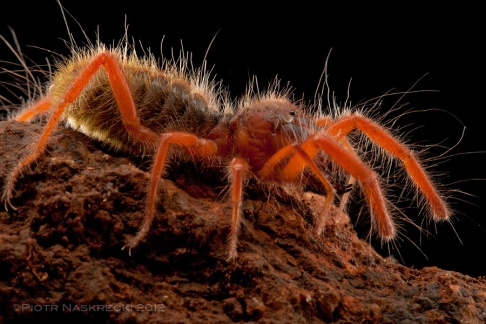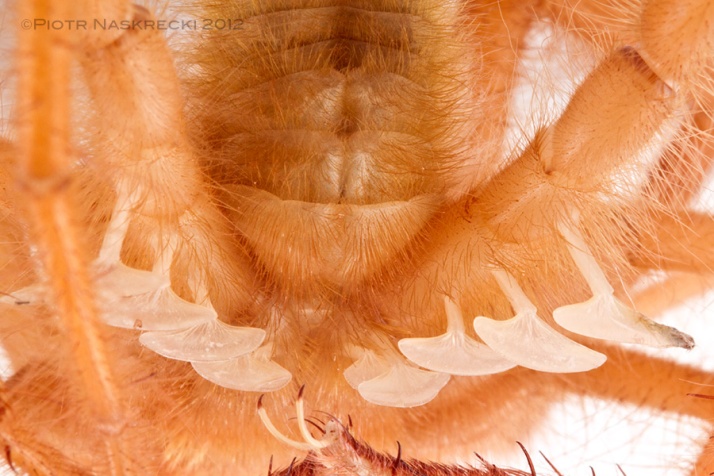
The body of a solifugid is covered with long hairs. These are sense organs, capable of detecting the tiniest changes in the temperature, humidity, or air movement (South Africa) [Canon 5D, Canon 100mm, speedlight Canon 580EX + Canon MT-24EX twin light]
Like everybody else, I have a soft spot for things that are fuzzy and look at me with expressive, big eyes. But of course being furry and having eyes isn?t necessarily equivalent to being cuddly, as I learned during a painful lesson delivered to me once by a silky anteater, whom I had foolishly picked up from a branch in Costa Rica ? turns out that its claws were not only good for ripping termite mounds open, they also worked great on human skin. And so when I saw my first solifugid, arguably the hairiest of all arachnids, it wasn?t too difficult to resist the temptation to pet it and snuggle against my cheek. In retrospect, probably a good decision.
The ?head?, or propeltidium, of a solifugid is a giant ball of muscles that power their huge chelicarea, and the first pair of ?legs? (pedipals) are usually held in the air, sensing for prey and danger. (Mozambique) [Canon 7D, Canon 100mm macro, 3 speedlights Canon 580EXII]
Solifugids (Solifugae) are the arachnid equivalent of a honey badger, the tireless, famously cantankerous African mammal. Like the badger, they are lonesome, opportunistic predators, constantly on the run, looking for something, anything, to sink their jaws in. They are big and they are fast. Really, really fast. Most are nocturnal and hate being exposed to the light (hence their name, Solifugae, Latin for ?fleeing from the sun?.) But some are active in the middle of the day, although still preferring to stay in the shade as much as possible. This, of course, sometimes leads to comical misunderstandings ? when you see a giant, hairy arachnid chasing you in the desert (and I can attest to the fact that it does happen!), be assured that it is after your shadow, not you per se. Just let it curl up against your leg, and all will be fine.
Solifugids are efficient hunters, capable of overpowering very large prey. Before swallowing their food they must macerate it very well, using a ?cheliceral mill.? [Canon 5D, Canon 100mm, Canon MT-24EX twin light]
Solifugids are found across the globe, mostly in hot, dry environments (curiously, they are absent from both Australia and Madagascar.) A handful of species live on the verges of wet, tropical forests, but these are rare (in all my years of working Costa Rica I have only seen one solifugid.) Little is known about the physiology of these animals, but they appear to be extremely tolerant of wide temperature changes, from near freezing to over 50?C (122?F), which is an adaptation to the daily temperature changes in the desert environment. At the same time, a solifugid may drop dead the moment it is exposed to the sun after being dug out from its burrow, likely indicating that their adjustment to extreme temperatures must be conducted in a gradual fashion.Unlike spiders, with which they are often confused, solifugids are not venomous. Probably not venomous. Those species that have been studied in detail lack venom glands, but there is some anecdotal evidence of possible envenomation of large prey items by these arachnids. Bites from solifuigids may also cause localized pain and swelling in humans, further indicating injection of toxins or histamines. Regardless, they are efficient killers of insects and other small animals, including frogs and lizards. They pursue their prey relentlessly. I once watched a solifugid going after an insect that hid under a rock, and never before had I been as grateful for being large as at that moment: these animals do not know the meaning of the words ?tired? and ?give up.?
The evolutionary history of soifugids is murky. Few fossils unequivocally recognized as solifugids exist, but it appears that they may be at least 300 million years old. Their closest relatives are also uncertain, but most arachnologists agree that they are closely related to pseudoscorpions. Among other arachnids they are unmistakable: their chelicerae (?jaws?) are so huge and muscular that it is easy to confuse them with the entire head of the animal. Solifugids are also equipped with strange, mushroom-like organs on the underside of their fourth pair of legs, known as the ?racuquet organs? or malleoli. Their function is not entirely clear, but they seem to be extremely sensitive organs of smell, and play a role in both detection of prey and finding a mating partner. Solifugids look as if they had five pairs of legs, but the first pair, the pedipalps, is in fact an element of the mouthparts. At the tip of the pedipals solifugids have unique suctorial organs that, like the suction cups on the arms of an octopus, help them catch and hold their prey.
I like solifugids, I like them very much. But I can understand why some people may be afraid of them. To be completely honest, solifugids are the only animals that I have never caught with my bare hands (and I have caught a lot of animals with my bare hands, vipers and scorpions included.) I know that they cannot really hurt me, even if they are mildly venomous (of which there is no firm evidence), but their gremlinish body and behavior tap right into my primordial fear of the agile and the unknown. Maybe next time I will try to pet one. Maybe.

The underside of solifugids? last pair of legs carries strange organs known as malleoli. Their exact function is not known, but they appear to be very sensitive scent organs. [Canon 7D, Canon 100mm macro, 3 speedlights Canon 580EXII]
Source: http://thesmallermajority.com/2012/11/09/solifugids-arachnid-teddybears-with-big-teeth/
nba trade deadline ncaa tournament marchmadness mike d antoni nba trade rumors 2012 ncaa tournament schedule laurent robinson
কোন মন্তব্য নেই:
একটি মন্তব্য পোস্ট করুন